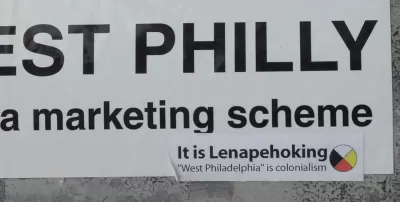Describing the Federal Reserve Bank of Philadelphia's recent study on gentrification in that city.

This month, the Federal Reserve Bank of Philadelphia came out with a study on "Gentrification and Residential Mobility in Philadelphia." This paper included some findings about displacement (or the lack thereof) in gentrifying neighborhoods.
The study described 56 Philadelphia census tracts as "gentrifying" based on a variety of criteria. Some of the questions the study sought to answer were:
- Are poorer residents of these tracts more likely to leave these neighborhoods than other city neighborhoods? Persons with the lowest credit scores (the study's surrogate for poverty) were about equally likely to leave gentrifying and non-gentrifying tracts. So if moving equals gentrification-related displacement, it does not seem especially frequent in gentrifying areas. Similarly, longtime residents (those living in the tract for over five years) were actually less likely to leave gentrifying tracts than other city neighborhoods.
- Were low-credit-score movers from gentrifying tracts forced into suburbia? A map of movers showed that high-credit-score movers were scattered throughout the region, while almost all low-credit score movers stayed within the city of Philadelphia. So it appears that despite media coverage of suburban poverty, few poor people moved from gentrifying areas to suburbs. (Of course, this pattern may be less true in high-cost central cities like New York and Washington.)
- Did low-scoring movers from gentrifying tracts shift to areas poorer than those gentrifying tracts? The study's answer to that question: No. The average low-score mover moved from a census tract with a median household income of $33,000 to one with a median income of $44,000. When intercity movers are excluded, this gap is narrower; even so, the movers wound up in areas with about a 10 percent higher median income than that of their former home (from $32,000 to $35,600). On the other hand, the "receiving" neighborhoods had lower home values than the gentrifying tracts, and fairly similar crime rates, and movers from some neighborhoods were less likely to move to richer areas. (Postscript: I also should have noted that intracity low-credit-score movers from non-gentrifying tracts improved their neighborhood status to a greater extent than those from gentrifying tracts; the average mover in this category left an area with a median income of just over $26,000 and moved to an area with a median income of almost $32,000- a 20 percent increase but still a lower median income, I note, than the movers from gentrifying tracts. This point seems to have created some confusion among readers: because movers from gentrifying tracts improved neighborhood quality to a lesser degree than movers from nongentrifying tracts, readers may have believed that movers from gentrifying tracts were objectively worse off than they had been had they not moved.)
In sum, it appears that at least in Philadelphia, many gentrification-related stereotypes are not consistently true. Low-credit score residents of gentrifying tracts were not especially mobile, nor did they always move to poorer areas when they did move.

Planetizen Federal Action Tracker
A weekly monitor of how Trump’s orders and actions are impacting planners and planning in America.

Maui's Vacation Rental Debate Turns Ugly
Verbal attacks, misinformation campaigns and fistfights plague a high-stakes debate to convert thousands of vacation rentals into long-term housing.

San Francisco Suspends Traffic Calming Amidst Record Deaths
Citing “a challenging fiscal landscape,” the city will cease the program on the heels of 42 traffic deaths, including 24 pedestrians.

Amtrak Rolls Out New Orleans to Alabama “Mardi Gras” Train
The new service will operate morning and evening departures between Mobile and New Orleans.

The Subversive Car-Free Guide to Trump's Great American Road Trip
Car-free ways to access Chicagoland’s best tourist attractions.

San Antonio and Austin are Fusing Into one Massive Megaregion
The region spanning the two central Texas cities is growing fast, posing challenges for local infrastructure and water supplies.
Urban Design for Planners 1: Software Tools
This six-course series explores essential urban design concepts using open source software and equips planners with the tools they need to participate fully in the urban design process.
Planning for Universal Design
Learn the tools for implementing Universal Design in planning regulations.
Heyer Gruel & Associates PA
JM Goldson LLC
Custer County Colorado
City of Camden Redevelopment Agency
City of Astoria
Transportation Research & Education Center (TREC) at Portland State University
Jefferson Parish Government
Camden Redevelopment Agency
City of Claremont






























